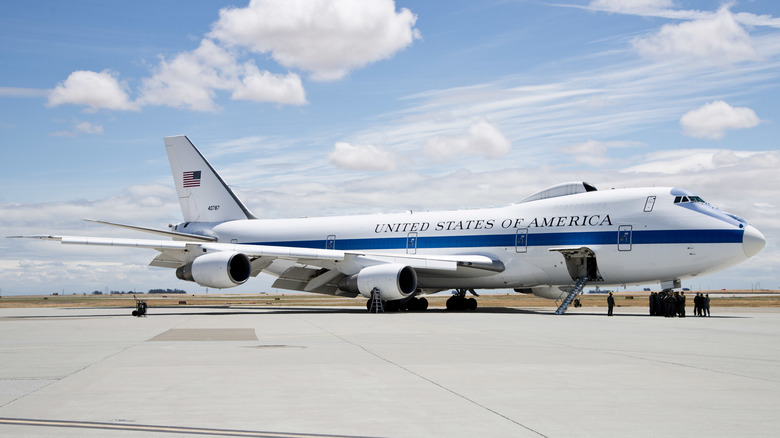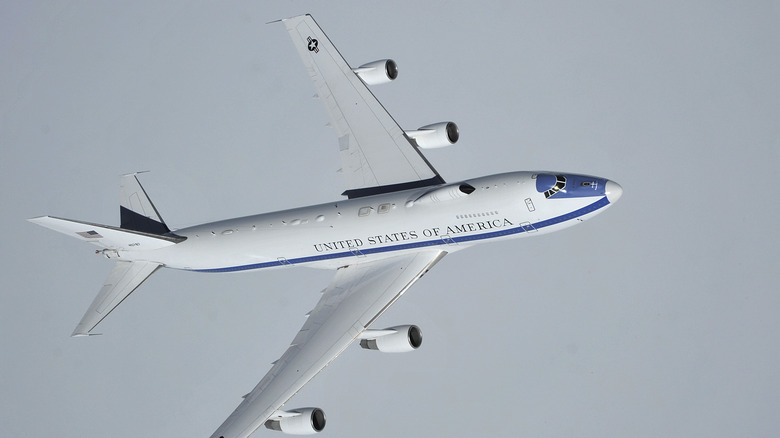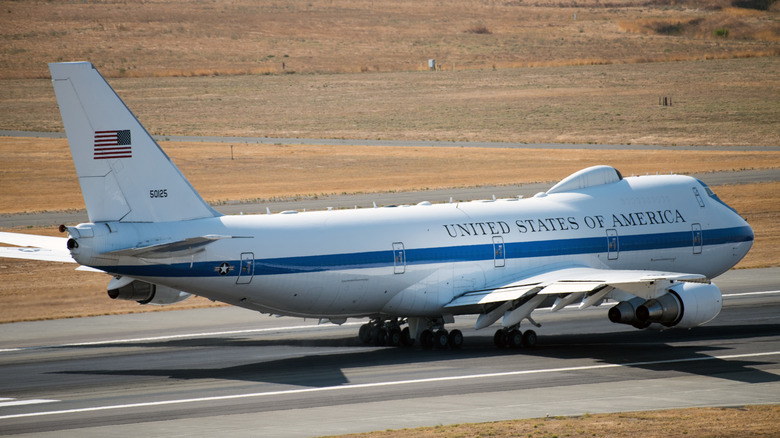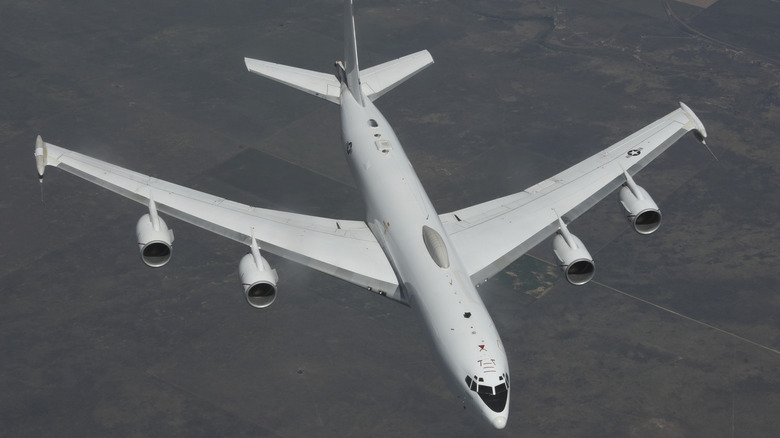Here's What The US Air Force's Brand-New Doomsday Jet Should Be Able To Do
Possessing over 5,000 nuclear warheads in silos, submarines, and reserve depots across the world (not just in-country), the U.S. nuclear forces (or "strategic forces") are some of the largest in the world — and it's in need of some serious upgrades. Since the end of the Cold War in the 1990s, the country has primarily focused on maintaining its existing stockpile of nuclear weapons and ensuring their readiness. Nonetheless, with rising threats from China, Russia, and potentially North Korea and Iran, the U.S. is poised to spend trillions over the next decade to overhaul every aspect of its strategic forces.
One such element slated for a massive upgrade is the E-4B Nightwatch, also known as the National Emergency Airborne Command Post (NEACP), as recently revealed by the Air Force. This aircraft serves as a flying command post, allowing the National Command Authority (NCA) to maintain communication with the country's nuclear assets during and after a nuclear attack. When necessary, the NCA can dispatch an Emergency Action Message (EAM) through the E-4B to strategic forces and initiate a counter-attack, thus earning it the ominous nickname "Doomsday Plane."
The E-4 fleet has been in service for over five decades, and while these aircraft were once state-of-the-art, they have become outdated in the 21st century. This past week, the U.S. Air Force awarded Sierra Nevada Corporation (SNC) a $13 billion contract to develop the next generation of these airborne command posts, known as the Survivable Airborne Operations Center (SAOC).
Prepping for War in Peace
A nuclear war is a strange game where the only winning move is not to play. This idea, popularized in the 1983 movie "WarGames," is a serious military strategy known as Mutually Assured Destruction, or MAD for short. MAD posits that if two nuclear-armed nations go to war, both would be obliterated, leaving no true winner. However, for MAD to be an effective deterrent, a country must possess a credible retaliatory capability. This means having the capacity to mount a massive counter-attack if struck with nuclear weapons, essentially ensuring no one would emerge unscathed.
In the U.S., this strategy extends beyond maintaining a diverse nuclear arsenal across the triad of land-based silos, strategic bombers, and submarine-launched missiles. The country also has a resilient command-and-control system, the National Military Command System (NMCS), to ensure the NCA can survive a first strike. This includes fixed command centers like the National Military Command Center beneath the Pentagon and the Alternate National Military Command Center in the Raven Rock Mountain Complex. However, these known bunker locations make them prime targets, so the U.S. developed a mobile, survivable NMCS component: the National Emergency Airborne Command Post. This includes a fleet of airborne command planes – now the E-4B Nightwatch – that can ensure orders reach strategic forces even if ground components are incapacitated.
The Anatomy of the Nightwatch
To understand the future SAOC, we must talk about the current E-4B NAOC. The E-4B is a heavily modified Boeing 747-200 with a fuselage hardened against electromagnetic pulses (EMPs) and radiation from nuclear blasts. Inside, you'll find dozens of computer consoles serving as terminals for the numerous advanced communication systems on board, ranging from multi-spectrum satellite communications (SATCOM) to 5-mile-long trailing wire antennas (TWAs) that allow the E-4B to contact ballistic missile-carrying submarines via Very Low Frequency (VLF) radio.
As a flying command center, the E-4B also features secured conference rooms and executive suites for VIPs, such as the Commander-in-Chief or the Secretary of Defense. Additionally, the E-4B is equipped with its own kitchen, water storage unit, and berthing facilities to accommodate the entire crew during emergencies.
For redundancy, the flight and battle staff of the E-4B are typically doubled. Every day, there's an E-4B with a flight crew of 63 on alert and ready to take off at any moment. In emergencies, the E-4B can accommodate up to 112 crewmembers – the largest crew capacity of any aircraft in the U.S. Air Force's inventory.
Since remaining airborne is the E-4B's top priority, it's capable of in-flight refueling from any tanker with a flying boom (which includes virtually every tanker in service with the U.S. Air Force today). With continuous refueling, the E-4B can remain airborne for a full week, limited only by the provisions aboard and the lubricants in its engines.
What the SAOC Will Look Like
While very few details are known about the SAOC at the moment (for obvious reasons), concept art already exists. The future plane will most certainly be based on the Boeing 747-8i –- the largest and last variant of the 747 produced by Boeing. Redundancy is crucial for an aircraft as vital as the SAOC, making the four-engine 747 the only suitable candidate for this role. In addition to offering extra space for more electronics compared to the older 747-200, the new GEnx turbofans should provide significantly better range and fuel efficiency than the old General Electric CF6 engines.
Operationally, the SAOC will take up the role the E-4B currently plays. Appearance-wise, the SAOC is remarkably similar to its predecessor, too, with a satellite communication (SATCOM) antenna bulb atop the 747's iconic hump. Scattered along the centerline of the SAOC's fuselage as well as the underside are antennae for the communication systems on board.
Small differences can be seen in the SAOC's concept art compared to the E-4B, though. For instance, atop the tail of the SAOC is a new antenna of unknown purpose. Given the U.S. Space Force's commitment to utilize commercial, militarized SATCOM like SpaceX Starshield, it may be a new receiver for such services.
The only component missing from the concept art is the VLF towed antenna array. However, considering its crucial importance, we believe it is simply omitted from the concept art rather than being absent from the SAOC altogether.
The SAOC Is Only Half of the Nuclear Equation
With radio range limitations and satellites being vulnerable to jamming and anti-satellite (ASAT) weaponry, the Looking Glass jets require communication relays to reliably coordinate with the nuclear triad. This mission, called TACAMO (Take Charge and Move Out), is currently handled by the Navy's E-6B Mercury. Basically, the E-6B acts as a middleman and uses its advanced comm relay systems to help the E-4B dispatch orders from the NCA to the rest of the strategic forces.
Uniquely, the E-6B is the only aircraft within the NMCS equipped with the Airborne Launch Control System (ALCS), capable of remotely unlocking and firing Minuteman intercontinental ballistic missiles. Essentially, in the standard U.S. nuclear game plan (called the "Single Integrated Operational Plan", or SIOP), if the E-4B serves as the brain, the E-6B wields the atomic sword.
But it's not just the E-4B that's approaching retirement. The E-6B, too, is on its way out. The E-4B will give way to the SAOC, meanwhile, the Boeing 707-based E-6B will be superseded by the EC-130J TACAMO, derived from the C-130J Super Hercules. This modernized Airborne National Command Post system, comprising the SAOC and EC-130J TACAMO, will fly together as a complete package — one that, hopefully, will never have to execute its primary function outside of simulations and drills.




